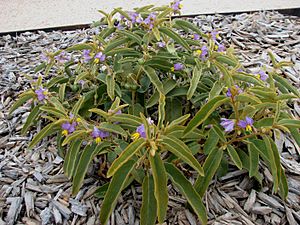Kutjera facts for kids
Quick facts for kids Australian desert raisin |
|
|---|---|
 |
|
| Scientific classification | |
| Genus: |
Solanum
|
| Species: |
centrale
|
The Solanum centrale, also known as the kutjera or Australian desert raisin, is a special plant that grows in the dry parts of Australia. For thousands of years, Aboriginal people in Central Australia have used its fruit as an important food source. It's one of many "bush tomatoes" found in the Australian outback.
A scientist named J.M. Black first officially described this plant in 1934.
Contents
About the Australian Desert Raisin Plant
Like many plants in its family (called Solanum), the desert raisin is a small, bushy plant. It often has thorns, which help protect it. This plant grows quickly and produces lots of fruit, especially in the year after a bushfire or good rainfall. It can even survive long droughts by staying dormant underground as root stock, then growing back when conditions improve.
What Does its Fruit Look Like?
The fruit of the desert raisin is packed with vitamin C. When it's fully ripe, it's yellow and about 1 to 3 centimeters wide. As the fruit dries on the bush, it shrinks and looks a lot like a raisin.
What Does the Fruit Taste Like?
These dried fruits have a strong, unique taste. People often describe it as a mix of tamarillo (a tangy fruit) and caramel. This interesting flavor makes them popular for cooking.
How is the Fruit Used?
You can find desert raisins sold whole or ground into a powder, often called "kutjera powder." This powder is easy to add to many dishes. You can mix it into bread dough, sprinkle it on salads, stir it into sauces, add it to cheese dishes, chutneys, or stews. It's also great mixed into butter for a flavorful spread.
Long ago, the Martu (an Aboriginal group) would put bush tomatoes on skewers and dry them. This made the food easy to carry when they traveled.
Growing Australian Desert Raisins
Traditionally, people collected the dried fruit from the small bushes in late autumn and early winter. In the wild, these plants only produce fruit for about two months each year.
Today, Aboriginal communities in the central Australian deserts grow desert raisins commercially. They use irrigation (watering systems) to help the plants grow. This allows them to extend the fruiting season to about eight months!
The fruit is grown by communities like Amata and Mimili in the Anangu Pitjantjatjara Yankunytjatjara lands. It's also grown by the Dinahline community near Ceduna, the Nepabunna community in the northern Flinders Ranges, and on the Tangglun Piltengi Yunti farm in Murray Bridge. The company Outback Pride helps market and sell these fruits.
Other Names for the Desert Raisin
| Language | Name |
|---|---|
| Alyawarr | Akatjurra |
| Arrernte | Merne akatyerre |
| English | Bush raisin, bush tomato, bush sultana |
| Pitjantjatjara | Kampurarpa |
See also
 In Spanish: Solanum centrale para niños
In Spanish: Solanum centrale para niños

